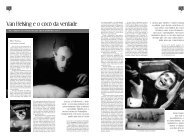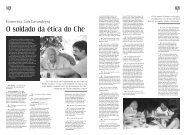Merleau-Ponty, 1964. Eye and mind. - Biolinguagem
Merleau-Ponty, 1964. Eye and mind. - Biolinguagem
Merleau-Ponty, 1964. Eye and mind. - Biolinguagem
- No tags were found...
Create successful ePaper yourself
Turn your PDF publications into a flip-book with our unique Google optimized e-Paper software.
develops a way of extending itself actively into that space which sub-tends the spatiality<br />
of a thing quite as much as that of a man or an apple tree. It is just that, as Klee said, to<br />
give the generating axis of a man the painter "would have to have a network of lines so<br />
entangled that it could no longer be a question of a truly elementary representation." 50<br />
In view of this situation two alternatives are open, <strong>and</strong> it makes little difference which one<br />
is chosen. First, the painter may, like Klee, decide to hold rigorously to the principle of the<br />
genesis of the visible, the principle of fundamental, indirect, or—as Klee used to say—<br />
absolute painting, <strong>and</strong> then leave it up to the title to designate by its prosaic name the<br />
entity thus constituted, in order to leave the painting free to function more purely as a<br />
painting. Or alternatively he may undertake, with Matisse (in his drawings), to put into a<br />
single line both the prosaic, identifying characteristics of the entity <strong>and</strong> the hidden<br />
operation which combines such indolence or inertia <strong>and</strong> such force in it as are required to<br />
constitute it as nude, as face, as flower.<br />
There is a painting by Klee of two holly leaves, done in the most representational manner.<br />
At first glance the leaves are thoroughly indecipherable, <strong>and</strong> they remain to the end<br />
monstrous, unbelievable, ghostly, on account of their exactness. And Matisse's women<br />
(let us keep in <strong>mind</strong> his contemporaries' sarcasm) were not immediately women; they<br />
became women. It is Matisse who taught us to see his shapes not in a "physical-optical"<br />
way but rather as structural filaments [des nervures], as the axes of a corporeal system of<br />
activity <strong>and</strong> passivity. Whether it be representational or nonrepresentational, the line is no<br />
longer a thing or an imitation of a thing. It is a certain disequilibrium contrived within the<br />
indifference of the white paper; it is a certain hollow opened up within the in-itself, a<br />
certain constitutive emptiness—an emptiness which, as Moore's statues show decisively,<br />
sustains the supposed positivity of things. The line is no longer the apparition of an entity<br />
upon a vacant background, as it was in classical geometry. It is, as in modern<br />
geometries, the restriction, segregation, or modulation of a pre given spatiality.<br />
Just as painting has created the latent line, it has made for itself a movement without<br />
displacement, a movement by vibration or radiation. And well it should, since, as they<br />
say, painting is an art of space, is carried out upon a canvas or sheet of paper <strong>and</strong> so<br />
lacks the wherewithal to devise things that actually move. But an immobile canvas could<br />
suggest a change of place, just as a shooting star's track on my retina suggests a<br />
transition, a motion not contained in it. The painting itself would then offer to my eyes<br />
almost the same thing offered them by real movements: a series of appropriately mixed,<br />
instantaneous glimpses along with, if a living thing is involved, attitudes unstably<br />
suspended between a before <strong>and</strong> an after—in short, the externals of a change of place<br />
which the spectator would read from the imprint it leaves. Here Rodin's well-known<br />
remark reveals its full weight: instantaneous glimpses, unstable attitudes petrify<br />
movement, as is shown by so many photographs in which an athlete-in-motion is forever<br />
frozen. We could not thaw him out by multiplying the glimpses. Marey's photographs, the<br />
cubists' analyses, Duchamp's La Mariee do not move; they give a Zenonian reverie on<br />
movement. We see a rigid body as if it were a piece of armor going through its motions; it<br />
is here <strong>and</strong> it is there, magically, but it does not go from here to there. Cinema portrays<br />
movement, but how Is it, as we are inclined to believe, by copying more closely the<br />
changes of place We may presume not, since slow motion shows a body being carried<br />
along, floating among objects like seaweed, but not moving itself.<br />
Movement is given, says Rodin, by an image in which the arms, the legs, the trunk, <strong>and</strong><br />
the head are each taken at a different instant, an image which therefore portrays the<br />
body in an attitude which it never at any instant really held <strong>and</strong> which imposes fictive<br />
linkages between the parts, as if this mutual confrontation of incompossibles could—<strong>and</strong><br />
alone could—cause transition <strong>and</strong> duration to arise in bronze <strong>and</strong> on canvas. 51 The only<br />
16









